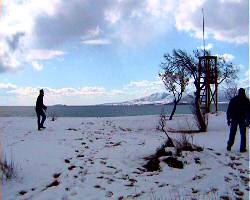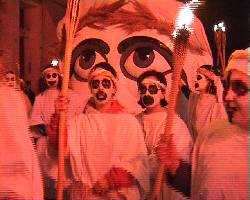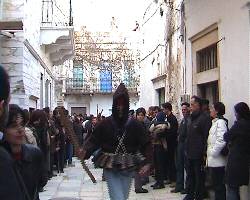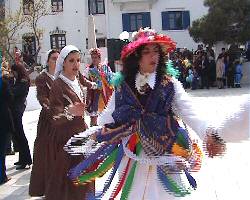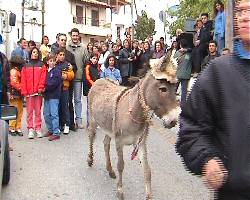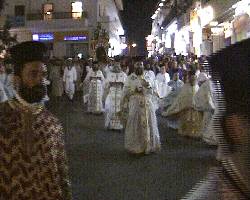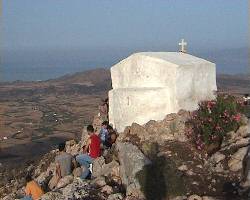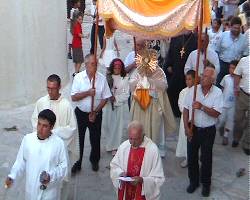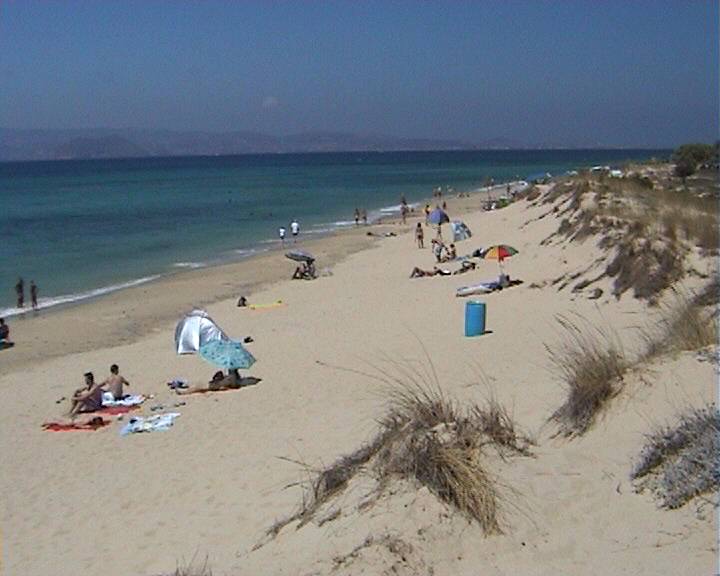Sites and Sounds
of
four seasons landscapes,
mountain routes, beaches,
traditional customs, local
events,
festivals, contemporary life
DVD -
Jan.-Aug. 2001-2005
|
The “Sites & Sounds” series, is not
narrated, neither provided with a choice of subtitles in different languages.
The series intends to carry the viewer on the location of the scene, as if he
or she were in the shoes of the people on the scene. Yet, to prevent
unanswered questions, or inquisitions that may arise, a short informative
text is provided here. The list corresponds to the order of the titles on the
DVD. This is not to quench your thirst for knowledge, but rather to whet your
appetite. |
|
Έχει
συζητηθεί
πολλές φορές,
έχει γραφεί
στον τύπο, έχει
αποτελέσει
θέμα σε
εισήγηση σε
τοπικό συνέδριο:
οι τοπικές
εκδηλώσεις, τα
παραδοσιακά λαϊκά
δρώμενα,
τείνουν να
γίνονται
πλέον στημένα, για
τους
τουρίστες. Κι
όμως οι
εκδηλώσεις
στην εκτός
τουριστική
περίοδο εποχή,
διατηρούν την
αυθεντικότητα
και τη
γνησιότητα
τους. Σε
αυτήν την
σειρά, τίποτε
δεν είναι
σκηνοθετημένο.
Οι ταινίες,
τραβηγμένες
με μία απλή
ψηφιακή κάμερα
χειρός, δεν
τραβούν πλέον
την προσοχή
κανενός στην
φωτογράφο,
κανένας δεν
ποζάρει, όλα
καταγράφονται
αυθόρμητα όπως
γίνονται. Η
απουσία
αφήγησης στην
σειρά αυτή,
υπήρξε συνειδητή
επιλογή. Όπως
και η μη
προσθήκη
μουσικής στο μοντάζ.
Σκοπός, να
μεταφερθεί ο
θεατής στην
σκηνή των
δρώμενων σαν
να ήταν ο ίδιος
εκεί. Αντί
αφήγησης,
παρατίθενται
στη σελίδα
αυτή σχετικά
πληροφοριακά
κείμενα, καθώς
και
παραπομπές σε
περαιτέρω
σχετική
βιβλιογραφία. |
|
Titles 1, 2 &3: Snow, snow,
snow. Don’t be misled. It rarely snows on the island. Snow-clad and
snow-covered? Three to maybe five days a year. Snowbound? Maybe a couple of
days a year -the villages of higher altitudes. So, photographing the island
in white, is a no-miss rare opportunity. Let alone photographing a beach with
…snow-white dunes. |
|
Οι
τρεις πρώτες
ταινίες,
καταγράφουν
τοπία του νησιού
χιονισμένα,
από τα ορεινά
ως και τις
παραλίες.
Χιονίζει
σπάνια στη
Νάξο, ίσως δύο
ως τρεις φορές
τον χρόνο. Οι
χιονοσκεπείς
παραλίες
είναι ακόμα
πιο σπάνιο
φαινόμενο,
ίσως μία φορά
την δεκαετία,
και για τον
φωτογράφο
αντικείμενο
που δεν θέλει
με τίποτε να
χάσει. Στη
Νάξο
λειτουργεί
Μετεωρολογικός
Σταθμός, και υπάρχει
και Σύλλογος
Χειμερινών
Κολυμβητών. |
|
Further
reading
/
Σχετική βιβλιογραφία:
*Περιβαλλοντική
Ομάδα Λυκείου
Νάξου: Μια
μελέτη για το
κλίμα της
Νάξου. Έκδοση
Δημήτρης
Βελώνης, 1997. |
||
|
Title 4: Introduced by
innovative members of the local “Cinematic Club” some 14 years ago,
“Torchlight Procession” has been hilariously welcome, and held since, as an
annual Carnival event, on the last Saturday before the Lent. Preparations
take place at the former |
|
Η
“Λαμπαδηφορία”
δεν είναι
τοπικό έθιμο.
Είναι εκδήλωση
που καθιέρωσε
εδώ και περίπου
14 χρόνια η
τοπική
Κινηματογραφική
Λέσχη, και
γίνεται με
μεγάλη
συμμετοχή
κάθε χρόνο το
τελευταίο
Σάββατο της
Αποκριάς.
Μικροί και
μεγάλοι μαζεύονται
νωρίς το βράδυ
στο κτίριο της
πρώην Σχολής
Ουρσουλινών,
στο Κάστρο της
Χώρας Νάξου,
όπου ντύνονται,
βάφονται, και
ξεχύνονται
στους
κεντρικούς
δρόμους. |
|
Further
reading
/
Σχετική
βιβλιογραφία: *Μπάκαλος
Β.:
Λαμπαδηφορία – Torchlight Procession. Έκδοση beautiful day 2002. |
||
|
Title 5: One of the
names the island is referred to, in antiquity, is “Dionyssias”. |
|
Οι
Κουδουνάτοι,
λέγεται ότι
είναι
κατευθείαν
απόγονοι του
Διονύσου και
των αρχαίων
τελετών που γινόταν
προς τιμήν του.
Ένα από τα
αρχαία
ονόματα της
Νάξου ήταν
Διονυσιάς, και
ναός
αφιερωμένος
στον Διόνυσο,
ανακαλύφθηκε
και
αποκαταστάθηκε,
στα Ύρια κοντά
στην πόλη της
Νάξου. Την τελευταία Κυριακή της Απόκριάς, οι Κουδουνάτοι κάνουν το χωριό της Απειράνθου να αντηχεί. Παλιότερα αυτό διαρκούσε όλη την Τυρινή εβδομάδα. Το έθιμο είναι χαρακτηριστικό, αλλά όχι μοναδικό εδώ, Κουδουνάτους θα συναντήσουμε και π.χ. και στην Χίο, τη Μυτιλήνη, κ.α. Μελετητές βρίσκουν ομοιότητες και με τις αρχαίες εορτές των Ανθεστηρίων που γίνονταν περίπου την ίδια εποχή, στην εναλλαγή της άνοιξης. |
|
Further
reading
/
Σχετική
βιβλιογραφία: *Κεφαλληνιάδης
Ν.: Η Απείρανθος.
Έκδοση ΠΛΟΑ 1985. *Κεφαλληνιάδης
Ν.: Η Πορτάρα της
Νάξου. Έκδοση
Δήμος Νάξου, 2001.
σελ. 23-37. *Οικονομίδης
Δ.: Ο Διόνυσος
και η άμπελος
εν Νάξω κατά
τας αρχαίας
και νεωτέρας
παραδόσεις.
Απεραθίτικα, 1
έτος ΙΙΙ, 1990, σελ.
127-147. *Πρωτοπαπαδάκη
Ειρ.: Το ψυχολογικό
υπόβαθρο των
αποκριάτικων
μεταμφιέσεων.
Πρακτικά Α’
Πανελλήνιου
Συνεδρίου ‘Η Νάξος
δια μέσου των
αιώνων’, σελ. 1013-1020. *Tripet-Pedis F.:
Οι αρχαίες
μαρτυρίες για
τη λατρεία του
Διονύσου στη
Νάξο. Πρακτικά
Α’ Πανελλήνιου
Συνεδρίου ‘Η Νάξος
δια μέσου των
αιώνων’, σελ. 161-165. |
||
|
Title 6: “Kordellati” (ribbon-men), “Levendes” (brave-men),
“Amalias” (well, this is self-explaining). Traditional carnival costumes of
the “Livadochoria” (lower villages) of the island. Besides the dance held on
the last Sunday of the Lent in the main squares of Tripodes and Agersani, the
inhabitants of the villages Kinidaros, Engares and Melanes, also traditionally exchange
visits of masqueraded men, often massively and in full armor (well, we ‘re
talking 19th century technology) and the resulting smoking gun noise. The “Kordellati” costume is supposed to render the men beautiful and
attractive. Together with the “Levendes” they set off for the next village to
conquer the women, and no woman, maiden or married, indigenous or alien, is
allowed to refuse a dance with the masqueraded men. The custom is considered
to have its roots in the years of piracy, and a reminiscent of the
corresponding activities of the corsairs. |
|
Κορδελάτοι,
Φουστανελάδες,
Λεβέντες,
Κλέφτες, Αμαλίες.
Στολές,
φιγούρες, και
ρόλοι. Κάθε
απόκριες, τα
σεντούκια στα
λεγόμενα
λιβαδοχώρια
(Τρίποδες,
Αγερσανί,
Ποταμιά,
Κινίδαρο,
Εγγαρές)
ανοίγουν, οι
πατροπαράδοτες
στολές,
σιδερώνονται
προσεκτικά.
Την τελευταία
εβδομάδα της
αποκριάς, οι
μασκαρεμένοι
των χωριών
ανταλλάσσουν
επισκέψεις,
συνοδεία
τουφεκιών,
μουσικής και
χορού. Σε ένα
έθιμο, που
λέγεται πως
έχει τις ρίζες
του στην εποχή
της πειρατείας,
οι Κορδελάτοι
και οι Κλέφτες,
ζητούν από τις
κοπελιές των
χωριών να
χορέψουν μαζί
τους, και καμία,
ακόμα και οι
ξένες, δεν
μπορεί να
αρνηθεί. |
|
Further
reading
/
Σχετική
βιβλιογραφία: *Κεφαλληνιάδης
Ν.: Αγερσανί
Νάξου. Έκδοση
Συλλόγου Αγ.
Αρσενίου
Νάξου, 1987. σελ. 281-284. *Κεφαλληνιάδης
Ν.: Ποταμιά.
Έκδοση του
Συλλόγου Ποταμιτών
Νάξου, 1996. σελ. 236. *Κεφαλληνιάδης
Ν.: Τρίποδες.
Έκδοση
Συλλόγου
Τριποδιωτών, 1979.
σελ. 112-113. *Σέργης Μ.:
Λαογραφικά
και
εθνογραφικά
από το Γλινάδο
Νάξου. Έκδοση
του
Προοδευτικού
Ομίλου Γλινάδου
Νάξου, 1994. σελ. 429-432. |
||
|
Title 7: “Donkeys on the Roof”? Well, this has an
explanation! Back in the old days, the roofs of the village were made of
soil, of beaten earth –to use the technical term. Like everyone knows, on
soil and earth, grass and other vegetation grow. So, they get these
sympathetic animals on the roofs to eat the plants, comfort their hunger
themselves and clean the roofs for their proprietors. It’s been a long time
since the roofs are made of cement instead of beaten earth, but the
generations old custom remains. |
|
Γαϊδουράκια
στις στέγες;
Υπάρχουν δύο
εκδοχές για
αυτό το
περίεργο
πρωτομαγιάτικο
έθιμο, και εδώ θα
μεταφέρω την
πιο
ορθολογική,
όπως την
άκουσα στο
χωριό. Στον
Κινίδαρο,
λοιπόν, παλιά,
όπως και στα
άλλα χωριά, οι
στέγες των
σπιτιών, τα
δώματα, ήταν
φτιαγμένα από
πατημένο χώμα,
και πάνω σ αυτό
βλάσταιναν
σπόροι που
μετέφερε ο
άνεμος. Για να
ξεχορταριάσουν
λοιπόν τα δώματα
τους, ανέβαζαν
τα
γαϊδουράκια
στις στέγες. Εδώ
και πολλές
δεκαετίες τα
δώματα είναι
πλέον τσιμεντένια,
αλλά το
πατροπαράδοτο
έθιμο
διατηρείται. |
|
Further
reading/
Σχετική
βιβλιογραφία : *
Κεφαλληνιάδης
Ν.: Το Δημοτικό
Τραγούδι εις
τον Κινίδαρον
Νάξου.
Επετηρίς
Εταιρίας
Κυκλαδικών
Μελετών, τόμ. Γ’,
1963, σ.697-815. |
||
|
Title 8: Processions of
the Holy Icons and of Holy Relics, are part of the tradition in the Greek
Orthodox Church, and Naxos is no exception. On St. Nikodemus Day, however, the
most massive, loud, and profoundly formal, procession takes place through the
main streets and the waterfront of the Town. Being the mid of high-season,
the crowd of worshipers and pilgrims attracts hundreds of curious tourists. St. Nikodemus is one of the five Saints of the “Metropolis of Paros
and Naxos”, saints that were “children” of these islands. Born in Naxos in
1749, resided since 1775 in the Holy Mountain, authored more than 100 (sic)
books, and has been subject to scholarly study. Several volumes of minutes of
conferences on St. Nikodemus can be found alone in the local municipal
library. |
|
Η πιο
λαμπρή και πιο
επίσημη από
όλες τις
εορτές της
Ελληνορθόδοξης
Εκκλησίας στη
Νάξο, είναι η
εορτή του Αγίου
Νικόδημου.
Κορύφωση της,
είναι η
Λιτάνευση των Ιερών
Εικόνων και
Λειψάνων, και η
ρίψη πληθώρας
πολύχρωμων
εντυπωσιακών
πυροτεχνημάτων.
Η συμμετοχή
στη λιτάνευση
φαίνεται
ακόμα
μαζικότερη,
καθώς γίνεται
μέσω των
κεντρικότερων
οδών της πόλης,
εν μέσω αιχμής
της
τουριστικής
περιόδου. Ο Άγιος Νικόδημος, είναι ίσως ο πιο εξέχων από τους πέντε Αγίους της Ιεράς Μητρόπολης Παροναξίας, καθώς υπήρξε συγγραφέας περισσότερων από 100 βιβλίων, και πρόσφατα αντικείμενο μελετών και συνεδρίων. |
|
Further
reading
/
Σχετική
βιβλιογραφία: *Μοστράτος
Αλ.: Οι Άγιοι του
τόπου μας. Ιερά
Μητρόπολις
Παροναξίας,
Εορτολόγιον 1999,
σελ. 8-52. *
Μοστράτος Αλ.: Ο
Άγιος
Νικόδημος ο Αγιορείτης.
Ιερά
Μητρόπολις
Παροναξίας,
Εορτολόγιον 2000,
σελ. 8-55. |
||
|
Title 9: Shrines used to
be built on hill and mountain tops ever since the Minoan times. This
millennia old habit survived through the centuries, only the gods changed.
The late author Chatzidakis, in his article “Περιήγησις εις Κρήτην” (Wandering
through Crete) interprets this custom, as a need of humans “to serve and pray
to God from the nearest possible” (“…ίνα εκ του σύνεγγυς παρακαλέσωσιν τον Θεόν”). Most of these mountaintop
chapels are dedicated to Prophet Elias, the best known of which in Greece, is
the one on top of Mt. Taygetus. On Naxos alone, I am aware of three namesake
hilltop chapels. The Prophet is honoured this way, commemorating his ascent
to the heavens. Probably the pilgrims by ascending to mountain top are trying
to be as close as possible to the Prophet and the Heavens. This particular chapel belongs to the Municipal Department -and the
Parish Church- of Damarionas, but on the Prophets Day, people from the villages
from both sides of the mountain climb up the steep paths for the Liturgy. By the way, Prophet Elias is the Patron Saint protector of the greek
mountaineers. On (or around) the 20th of July the Pan-Hellenic
Gathering of Greek Mountaineering Clubs, takes place on a different Hellenic
mountain every year. |
|
Τα
περισσότερα
από τα
ξωκλήσια που
είναι κτισμένα
σε κορυφές
βουνών είναι
αφιερωμένα
στον Προφήτη
Ηλία. Κι αυτό
σύμφωνα με την
παράδοση, για
να τιμηθεί η ανάληψη
του Προφήτη
στους
Ουρανούς. Στην
Νάξο υπάρχουν
τουλάχιστον
τέσσερα
αφιερωμένα
στον Προφήτη.
Αυτό, στον
απότομο λόφο
των 585 μ., μεταξύ
των χωριών Σαγκρίου
και Δαμαριώνα,
ένα από τα δύο
που
παραδοσιακά
εξακολουθούν
να
λειτουργούνται,
την ημέρα εορτής
του Προφήτη. Τι
είναι αυτό
όμως που κάνει
τους πιστούς
κάθε ηλικίας
να
σκαρφαλώνουν
αξημέρωτα τα
απόκρημνα
μονοπάτια για
το πανηγύρι; Ο
Ιωσήφ Χατζηδάκης,
στο
οδοιπορικό
του
“Περιήγησις
εις Κρήτην”,
έγραφε στις
αρχές του
περασμένου
αιώνα “…ίνα εκ
του σύνεγγυς
παρακαλέσωσιν
τον Θεόν”. Σε μία
συνεχή
παράδοση, στον
ελλαδικό χώρο,
τα σημερινά
αυτά ιερά στις
κορυφές, θα
μπορούσαν να
είναι οι
συνεχιστές
των μινωικών
ιερών κορυφής.
Μόνον οι θεοί
έχουν αλλάξει. |
|
Further
reading
/
Σχετική
βιβλιογραφία: *Κεφαλληνιάδης
Ν.: Δαμαριώνας.
Έκδοση Συνδέσμου
Φίλων
Δαμαριώνος, 1979.
σελ. 164. *Πλάτων Ν.:
Το Ιερόν Μαζά
Καλού Χωριού
Πεδιάδος και τα
Μινωικά Ιερά
Κορυφής. Κρητικά
Χρονικά, τόμ. Ε’,
1951. *Σακελλαράκης
Γ.: Η ιερά πορεία
των ευσεβών
εις την Ίδην
την Κρήτης.
Προσκυνήματα
στον
Ψηλορείτη το 1860 και
το 1872. Κρητικά
Χρονικά, τόμ. Λ’,
1970, σελ. 18-34. *Χατζηδάκης
Ιωσ.:
Περιήγησις
εις Κρήτην.
Κρητική Εστία,
τ.77-105, 1978-. *Ψιλάκης Ν.:
Μοναστήρια
και
ερημητήρια
της Κρήτης. 1992. |
||
|
Title 10: Agia Dorea,
celebrated every July, 60 days after Easter, is probably the most popular of
all celebrations among the local Roman Catholic Church. The Catholic
Cathedral Church, is chock-full, the Holy Mass and Procession being also
attended by visitors and orthodox alike. The procession on its way through
the alley ways of the Castle, stops at altars especially placed outside
houses on this Day, as well as at the Church of the Immaculate Conception
–known as the Capella Casazza. Afterwards every one is invited for a cocktail
come-together at the Catholic Archiepiscopal Mansion, which used to be the
Palace of the Dukes of the Duchy of the Aegean. Most of the Catholics are descendants
of the franco-latin lords of the Duchy, and still mostly live in the quarters
of the Castle. Catholics and orthodox also mingle during the processions of
the Epitaph, and many Orthodox tend to come to the Cathedral at the Castle to
celebrate Easter. |
|
Η
πανήγυρη της
Αγίας Δωρεάς,
που
εορτάζεται
κάθε χρόνο στα
τέλη του
Ιουλίου, είναι
η πιο λαμπρή
από όλες τις
εορτές της
Καθολικής
Εκκλησίας στη
Νάξο. Στην
εορτή και στην
λιτάνευση στα
σοκάκια του
Κάστρου,
συμμετέχουν
και πολλοί
επισκέπτες
αλλά και ορθόδοξοι.
Ψαλμοί ηχούν,
και στο
παρεκκλήσι
της Καπέλα
Καζάτζα, πριν η
πομπή
επιστρέψει
στον
καθεδρικό
Μητροπολιτικό
Ναό της
Υπαπαντής. Στο
τέλος, όλοι
είναι καλεσμένοι
στην Καθολική
Μητρόπολη, το
πάλαι ποτέ
Παλάτι του
Μάρκου
Σανούδου, και
Δουκών του
Αρχιπελάγους. |
|
Further
reading
/
Σχετική
βιβλιογραφία: *Κεφαλληνιάδης
Ν.: Το Κάστρο των
Σανούδων στη
Χώρα Νάξου.
Έκδοση Δήμος
Νάξου, 2000. *Κεφαλληνιάδης
Ν. Slot B.:
Οικόσημα στη
Νάξο. 1980. *Κουρουπάκη
Κ. Σάββαρη Ελ.
Σταθάκη
Σπηλιωπούλου
Μ. Τσαμτσούρη Β.:
Ελληνική
Παραδοσιακή
Αρχιτεκτονική,
Νάξος.
Εκδόσεις
Μέλισσα, 1981. *Κωτσάκης
Θ.: Η Νάξος κατά
την Ενετοκρατία.
Εκδόσεις
Πελασγός, 2001. *Remoundos M. Karistineos
L.: The Roman Catholic Cathedral of Naxos. Catholic Archdiocese of Naxos
Tinos, 2002. |
||
|
Title 11: Granodiorite,
erosion, disposition. Sand culture. Sound too technical and unconnected? The western third of the island is mostly formed from granodiorite
masses. The rocks, eroded by the force of water and wind, are turned into
tiny grains, and finally disposed by rivers, torrents and floods to the
plains and coasts, forming what we all know and worship as golden fine sand
beaches, to which Naxos owes its ever growing touristic development. The main tourist bus line runs for about 8km along this golden west
coast to serve the crowds of sea-and-sun bathers. I followed it on a mid
summer day. |
|
Οι
παραλίες της
Νάξου, και
ιδιαίτερα οι
αμμουδιές της
δυτικής
πλευράς, είναι
το πιο
πολυφωτογραφημένο
θέμα στο νησί,
τόσο από
επαγγελματίες
όσο και από
ερασιτέχνες.
Οι παραλίες
αυτές είναι
εξάλλου ο
κύριος λόγος που
έρχονται οι
επισκέπτες
στο νησί, και ο
κύριος άξονας
της
τουριστικής
του ανάπτυξης. Ακολούθησα, με τα πόδια, την ακτογραμμή των παραλιών αυτών, από τον Άγιο Προκόπιο ως και το τέρμα των λεωφορείων στην Πλάκα, ένα μεσημεράκι του Αυγούστου. |
|
Further reading / Σχετική βιβλιογραφία: *Jansen J.B.H.: The Geology
of Naxos. Ι.Γ.Μ.Ε., τόμ.
XVII, 1997. *Naxos made easy. Summer
2004/05. Publisher AD CARE. |
||
|
Sites & Sounds - Volume II... |
coming... |
…soon... |
This page was last modified: Aug. 14th 2006. Please feel free to email me your suggestions and comments.
[ Hosted by Yahoo Geocities ] [Back to the main filmography page]
